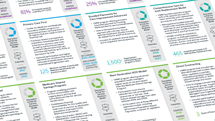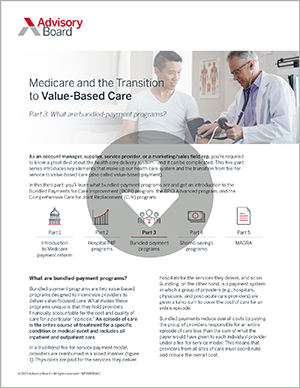Implementing bundled payments for several types of surgery helped health plans save nearly 11% on those services compared with previous payment models, and the plans were able to pass those savings along to employers and patients, according to a new study published in Health Affairs.
Infographic: The field guide to Medicare payment innovation
Bundled payments saved an average of $4,229 per procedure, researchers find
For the study, researchers from RAND Corp. set out to determine how a commercial health plan's implementation of bundled payments for certain orthopedic and surgical procedures could affect the plan's costs for those procedures when compared with previous payment models.
To do so, the researchers analyzed data from Carrum Health on payments for 2,372 procedures covered by self-insured employers between 2016 and 2020. The researchers compared the health plans' costs under previous payment models with their costs under a bundled payment model, through which the health plans negotiated preferred prices with certain providers that covered all costs for the procedures and related care within a 30-day period. Under the bundled payment model, health insurers and providers did not impose any cost-sharing requirements on affected patients.
The researchers noted that, after the bundled payment program's implementation, the health plans paid for 30% of gastrointestinal surgeries, 16% of joint replacement surgeries, and 23% of spinal fusion surgeries under the program.
The mean prices for gastrointestinal, joint replacement, and spinal fusion surgeries typically were $29,225, $38,498, and $98,944, respectively, under fee-for-service payment models. In comparison, the mean prices set under the bundled payment program were significantly lower, including a $1,600 difference, or a relative difference of 6%, for gastrointestinal surgery; a $7,143 difference, or a relative difference of 18.4%, for joint replacement surgery; and a $29,164 difference, or a relative difference of 29.1%, for spinal infusion surgery. Overall, the researchers found that average prices under the bundled payment model were between 6% and 41% lower when compared with prices at providers that didn't participate in the model, Bloomberg reports.
The researchers found that health plans saved an average of $4,229 per procedure under the bundled payment model, representing a 10.7% relative reduction in costs. The health plans then passed those savings along to employers and patients, the researchers said. Employers received about 85% of the average savings, or about $3,582 per episode, while patients' cost-sharing payments decreased by about $498 per episode.
According to the researchers, savings generated by the bundled payments program grew over time. Ultimately, employers saved $7 for every $1 in patients' waived cost-sharing requirements, the researchers estimated.
The researchers also found that quality of care for the procedures typically remained the same or improved slightly under the bundled payment program.
Should more health plans implement bundled payments?
Christopher Whaley, the lead author on the study and a policy researcher at RAND, said although employer-based health plans are increasingly implementing bundled payment programs, they typically apply only to "big-ticket" procedures.
"Maybe employers don't want to be the first ones to adopt something this new. Also, if employers aren't clamoring for these types of models and want to pass rising health care costs down to employees, there's not a large incentive for private payers to invest in these plans," Whaley said.
However, Whaley said the study's findings may help to fuel change on the matter. "[T]he sizable savings could help drive more employers and payers to this type of model," he said.
Whaley also noted that bundled payments have "worked well for Medicare," and "[s]avings could be quite a bit higher on the private market because prices are all over the map" (Kacik, "Transformation Hub," Modern Healthcare, 3/1; Whaley et al., Health Affairs, March 2021; Tozzi, Bloomberg, 3/1).

CMS's voluntary and mandatory payment innovation programs are accelerating the transition to accountable payment models.
This infographic breaks down the 12 highest profile programs as of March 2020—learn how these programs disrupt the traditional fee-for-service business model.
Don't miss out on the latest Advisory Board insights
Create your free account to access 1 resource, including the latest research and webinars.
Want access without creating an account?
You have 1 free members-only resource remaining this month.
1 free members-only resources remaining
1 free members-only resources remaining
You've reached your limit of free insights
Become a member to access all of Advisory Board's resources, events, and experts
Never miss out on the latest innovative health care content tailored to you.
Benefits include:
You've reached your limit of free insights
Become a member to access all of Advisory Board's resources, events, and experts
Never miss out on the latest innovative health care content tailored to you.
Benefits include:
This content is available through your Curated Research partnership with Advisory Board. Click on ‘view this resource’ to read the full piece
Email ask@advisory.com to learn more
Click on ‘Become a Member’ to learn about the benefits of a Full-Access partnership with Advisory Board
Never miss out on the latest innovative health care content tailored to you.
Benefits Include:
This is for members only. Learn more.
Click on ‘Become a Member’ to learn about the benefits of a Full-Access partnership with Advisory Board
Never miss out on the latest innovative health care content tailored to you.

